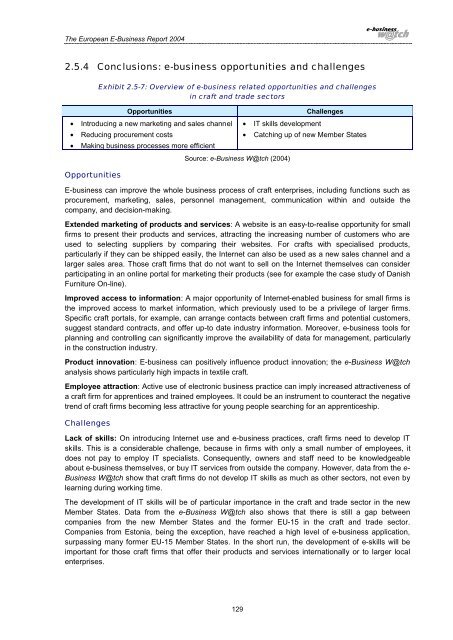The European e-Business Report 2004 - Berlecon Research GmbH
The European e-Business Report 2004 - Berlecon Research GmbH
The European e-Business Report 2004 - Berlecon Research GmbH
Create successful ePaper yourself
Turn your PDF publications into a flip-book with our unique Google optimized e-Paper software.
<strong>The</strong> <strong>European</strong> E-<strong>Business</strong> <strong>Report</strong> <strong>2004</strong>2.5.4 Conclusions: e-business opportunities and challengesExhibit 2.5-7: Overview of e-business related opportunities and challengesin craft and trade sectorsOpportunities• Introducing a new marketing and sales channel• Reducing procurement costs• Making business processes more efficientOpportunities• IT skills developmentSource: e-<strong>Business</strong> W@tch (<strong>2004</strong>)Challenges• Catching up of new Member StatesE-business can improve the whole business process of craft enterprises, including functions such asprocurement, marketing, sales, personnel management, communication within and outside thecompany, and decision-making.Extended marketing of products and services: A website is an easy-to-realise opportunity for smallfirms to present their products and services, attracting the increasing number of customers who areused to selecting suppliers by comparing their websites. For crafts with specialised products,particularly if they can be shipped easily, the Internet can also be used as a new sales channel and alarger sales area. Those craft firms that do not want to sell on the Internet themselves can considerparticipating in an online portal for marketing their products (see for example the case study of DanishFurniture On-line).Improved access to information: A major opportunity of Internet-enabled business for small firms isthe improved access to market information, which previously used to be a privilege of larger firms.Specific craft portals, for example, can arrange contacts between craft firms and potential customers,suggest standard contracts, and offer up-to date industry information. Moreover, e-business tools forplanning and controlling can significantly improve the availability of data for management, particularlyin the construction industry.Product innovation: E-business can positively influence product innovation; the e-<strong>Business</strong> W@tchanalysis shows particularly high impacts in textile craft.Employee attraction: Active use of electronic business practice can imply increased attractiveness ofa craft firm for apprentices and trained employees. It could be an instrument to counteract the negativetrend of craft firms becoming less attractive for young people searching for an apprenticeship.ChallengesLack of skills: On introducing Internet use and e-business practices, craft firms need to develop ITskills. This is a considerable challenge, because in firms with only a small number of employees, itdoes not pay to employ IT specialists. Consequently, owners and staff need to be knowledgeableabout e-business themselves, or buy IT services from outside the company. However, data from the e-<strong>Business</strong> W@tch show that craft firms do not develop IT skills as much as other sectors, not even bylearning during working time.<strong>The</strong> development of IT skills will be of particular importance in the craft and trade sector in the newMember States. Data from the e-<strong>Business</strong> W@tch also shows that there is still a gap betweencompanies from the new Member States and the former EU-15 in the craft and trade sector.Companies from Estonia, being the exception, have reached a high level of e-business application,surpassing many former EU-15 Member States. In the short run, the development of e-skills will beimportant for those craft firms that offer their products and services internationally or to larger localenterprises.129
















